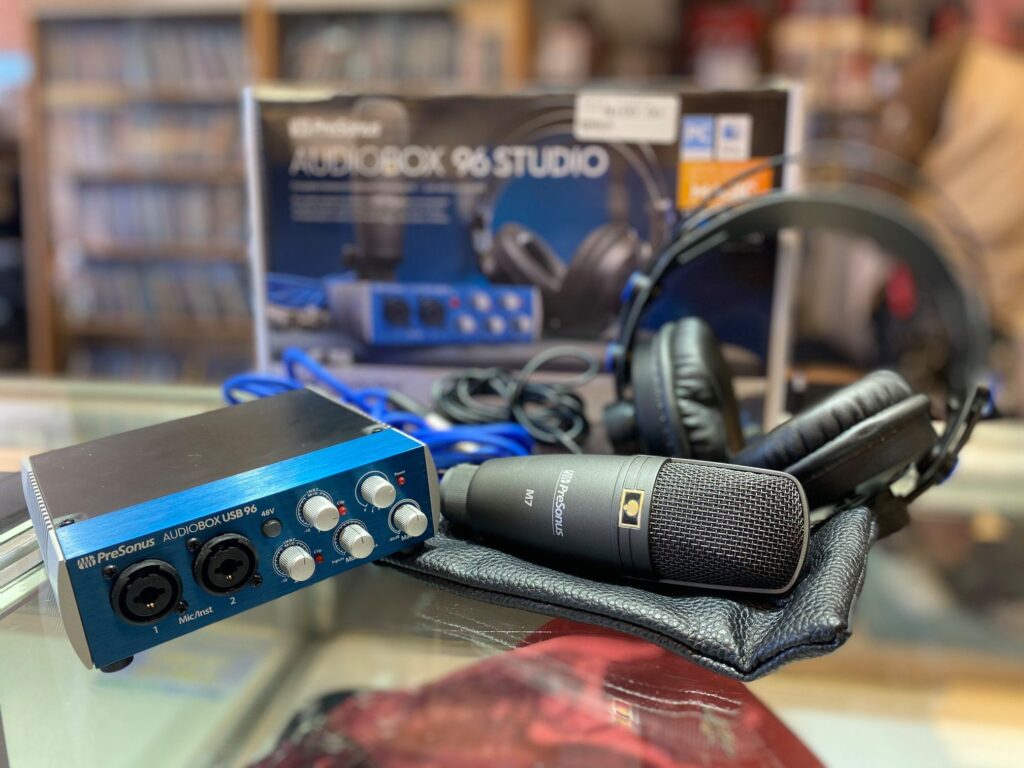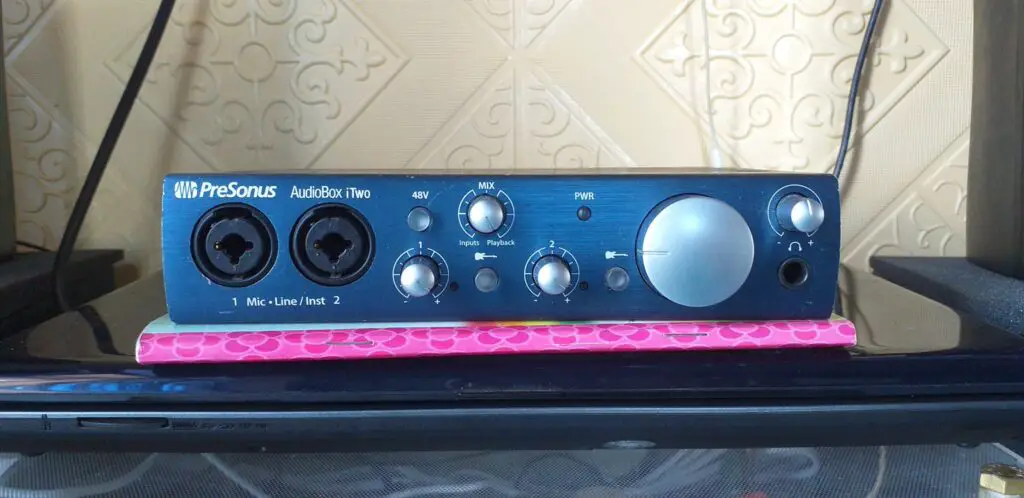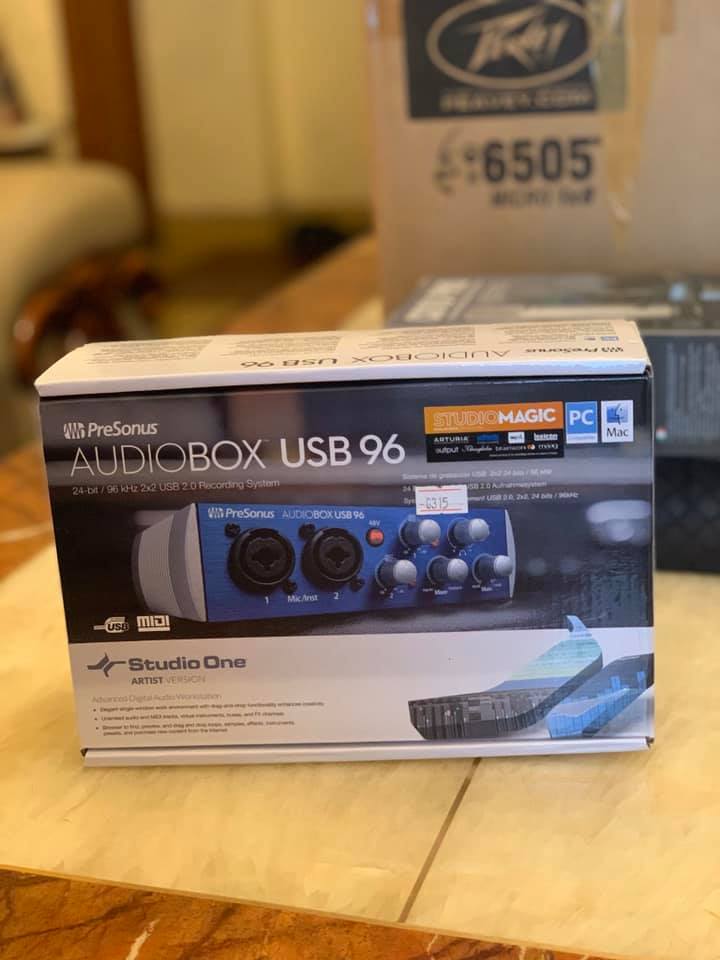Table of Contents
There are a lot of audio interfaces on the market, so it can be tough to decide which one is right for you. In this article, we’re going to compare the Presonus Audiobox 96 and the iTwo. The Audiobox 96 is a USB 2.0 interface with two mic/instrument inputs and two stereo outputs. It has a signal-to-noise ratio of 105 dB and a frequency response of 20 Hz to 22 kHz. The iTwo is also a USB 2.0 interface, but it has four mic/instrument inputs and two stereo
Presonus Audiobox 96 Vs iTwo: Comparison Chart
| Interface | AudioBox 96 | iTwo |
| Frequency | 20Hz-22KHz | 96khz |
| Ports | 2XLR Inputs with Audio Outputs | 2 USB in- 2 OUT |
| Software Bundle | YES | YES |
| Plugins | VST, AAX, and AU formats, DAW | VST, AAX, and AU formats, DAW |
| Connectivity | PC, MAC, LAPTOPS | IPAD, IPOD, IPHONES, COMPUTERS |
| Power | 48W Phantom Power | 2×2 USB |
Presonus Audiobox 96 Vs iTwo: Detailed Analysis
The Presonus AudioBox USB 96 is a tiny and straightforward 2×2-port USB bus-powered interface. Aside from the price, the fact that it is so simple to set up, plug and play, is what makes it interesting to novices.
The front panel is rather crowded, but in a good manner. On the left, there are two XLR/Line combo inputs, the second of which is followed by a 48 V phantom power button. Following that, there are independent gain controls for inputs one and two, each with a tiny LED to indicate clipping where as,
The iTwo is a 2-in-2-out USB interface with 24 bit / 96Khz capability housed in a tough brushed aluminium desktop container. It’s light due to the lack of an internal power supply, but it looks and feels solid. This is useful because portability is one of its main advantages. This is a dual-purpose gadget that can be used with either a Mac/PC or an iPad,
but not both simultaneously. You may record to an iPad using the included Capture Duo software, then wirelessly transfer your session to the bundled Studio One Artist package on your Mac or PC.
Design-

One of the most startling aspects of the PreSonus AudioBox USB 96 is its build quality. Given the price and size, you wouldn’t anticipate such a sturdy unit.
The entire interface is encased in metal, but the sides, in particular, are quite substantial. It appears to be tough enough to withstand a few knocks and bangs. That’s always comforting for an audio interface you’re likely to use while travelling.
The front-panel controls are robust and have a great smooth motion.
Overall, the build quality of the iTWO is extremely good. The strong aluminium enclosures feature a uniform colour finish and massive, industrial-looking fasteners on the corners
. However, there are some harsh edges where holes for the input sockets have been made, and the case’s edges could be a little nicer to the touch. Although unlikely to cause harm, this detracts from the overall quality. When tapped, the buttons feel a touch ‘hollow,’ but the gain and headphone level pots are more robust, with soft clicks to help in setting and matching levels.
MUST-READ| Blue Snowball Vs Blue Yeti USB Microphone: Review and Comparison!
Sound-

In terms of performance, the AudioBox has a few flaws. Audio is not recorded at the same loudness at extremely low and extremely high frequencies. There is a 2 dB drop-off at either end of the 20 Hz to 20 kHz spectrum.
It’s not a huge problem, and it won’t be the only interface with this issue, but it’s worth noting. When the gain is increased to nearly halfway, the response becomes significantly flatter.
It’s ideal to use a condenser microphone with the AudioBox rather than a dynamic microphone because they utilise less gain and so have a better chance of maintaining a flat frequency response. The advantage is that most prospective buyers may not even detect any flaws.
If you want to record on your iPhone or iPad, I don’t believe there is a better gadget available. From the feature set to the implementation, it’s evident that whoever created this item gave it some thought.
You can manage the mix between the sound coming in and your own instrument/mic, you can control the headphone output and master out separately, swap inputs between High-Z and Low-Z, offer phantom power…
Outstanding.
There may be better equipment available for computer recording. However, I cannot think of a better unit for iPhone/iPad applications than this. It’s neutral, with a flat response and a healthy dynamic range of 103dB. This unit can produce high-quality sound with a forgiving 24 bit headroom, offering beginners a wide margin of error.
Software Bundle-
PreSonus includes a copy of Studio One Artist, their own DAW. The user-friendly production programme enables you to create, record, and produce with minimal effort.
Despite its ease of use, it is a rather strong music producing instrument. PreSonus did an excellent job at keeping the layout simple and adding a lot of drag-and-drop capability. So, if you’re used to utilising a computer and the internet, Studio One Artist should be a breeze.
Studio One is designed to be utilised while connected to the internet, and it provides access to a vast range of plugins, effects, and virtual instruments. You also gain access to a large library of loops and sample content that you can use right away in your project also,
It also features a pretty great plugin package with emulation of old effects and instruments. All of these plugins are available in VST, AAX, and AU formats, allowing you to utilise them in any major DAW.
The bad news is that third-party plugins are not supported by Studio One Artist. To use third-party plugins, you must upgrade to Studio One Professional.
MUST-READ| Marshall Monitor II ANC Vs Marshall Mid ANC: Comparison
Input and Output-

On the left, AudioBox has two XLR/Line combo inputs, the second of which is followed by a 48 V phantom power button. Following that, you get independent gain controls for inputs one and two, each with a tiny LED, and a Mixer knob to blend between direct audio and DAW sound (USB).
Following that, you have a separate volume for your headphones and a main volume for your monitor outputs.
The iTWO front panel features two combo inputs that may be switched between line level or instrument on the 1/4in jack, or microphones via the XLR. The mic preamps are of the Class A variety, with switchable 48V phantom power and gain of up to 52dB. The inputs can be used in any order. However, phantom power can be switched on and off for both mic inputs at the same time. A headphone output with plenty of guts is easily situated on the front panel, next to its own independent volume control, while the main output levels are controlled by a big dial.
iTWO Mobile Recording-
One area where the iTWO excels is mobile recording. We’ve already discussed quality, but what it truly comes down to here is convenience. If you have an iPad, you can transform any location into your studio, which is fantastic.
It works in tandem with PreSonus’ Capture Duo iPad software. A arrangement like this would be useful in a variety of situations. It obviously allows you to record high-quality songs for your demos or releases, but it also allows you to capture ideas in better detail than you would with your smartphone microphone, which I’m sure we’ve all done at some point.
It’s also great for making high-quality recordings of rehearsal sessions.
Presonus Audiobox 96 Vs iTwo: Qucik Result
| Device | AudioBox 96 | iTWO |
| Portability | NO only works on PCs | YES, Mobile Connectivity |
| Connection | 48W Phantom Line, USB | USB 2.0 |
| Software Bundle | Studio One Artist | Studio One Artist |
Presonus Audiobox 96 Vs iTwo: Final Verdict
A few minor flaws hold it back in some places, but still holds its own against the competition. If you want a single interface for your home and travels, the iOne (or iTwo) is well worth considering. The AudioBox USB 96 does this brilliantly, and with a build quality much beyond its price, The AudioBox iTwo is nearly the perfect tiny interface.
MUST-READ| Sony WH-1000XM4 vs Surface Headphones 2: Comparison





